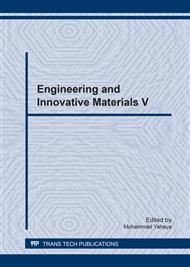[1]
Deinema, M.H. and Zevenhuizen, L. Formation of cellulose fibrils by gram-negative bacteria and their role in bacterial flocculation, Archiv für Mikrobiologie 1971. 78(1): pp.42-57.
DOI: 10.1007/bf00409087
Google Scholar
[2]
Römling, U, Molecular biology of cellulose production in bacteria, Research in microbiology 2002. 153(4): pp.205-212.
DOI: 10.1016/s0923-2508(02)01316-5
Google Scholar
[3]
Ross, P., Mayer, R., and Benziman, M, Cellulose biosynthesis and function in bacteria, Microbiological reviews 1991. 55(1): pp.35-58.
DOI: 10.1128/mr.55.1.35-58.1991
Google Scholar
[4]
Sani, A. and Dahman, Y. Improvements in the production of bacterial synthesized biocellulose nanofibres using different culture methods. Journal of chemical technology and biotechnology 2010. 85(2): pp.151-164.
DOI: 10.1002/jctb.2300
Google Scholar
[5]
Brown, A.J. XLIII, —On an acetic ferment which forms cellulose, Journal of the Chemical Society, Transactions 1886. 49: pp.432-439.
DOI: 10.1039/ct8864900432
Google Scholar
[6]
Iguchi, M., Yamanaka, S., and Budhiono, A., Bacterial cellulose—a masterpiece of nature's arts, Journal of Materials Science 2000. 35(2): pp.261-270.
Google Scholar
[7]
Sun, R. -C. Detoxification and separation of lignocellulosic biomass prior to fermentation for bioethanol production by removal of lignin and hemicelluloses. BioResources 2009. 4(2): pp.452-455.
Google Scholar
[8]
Park, J.K., Park, Y.H., and Jung, J. Y, Production of bacterial cellulose byGluconacetobacter hansenii PJK isolated from rotten apple. Biotechnology and Bioprocess Engineering 2003. 8(2): pp.83-88.
DOI: 10.1007/bf02940261
Google Scholar
[9]
Nakagaito, A., Iwamoto, S., and Yano, H, Bacterial cellulose: the ultimate nano-scalar cellulose morphology for the production of high-strength composites, Applied Physics A 2005. 80(1): pp.93-97.
DOI: 10.1007/s00339-004-2932-3
Google Scholar
[10]
Bae, S. and Shoda, M, Statistical optimization of culture conditions for bacterial cellulose production using Box-Behnken design. Biotechnology and bioengineering 2005. 90(1): pp.20-28.
DOI: 10.1002/bit.20325
Google Scholar
[11]
Dayal, M.S. and Catchmark, J. M, Mechanical and structural property analysis of bacterial cellulose composites, Carbohydrate Polymers 2016. 144: pp.447-453 DOI: 10. 1016/j. carbpol. 2016. 02. 055.
DOI: 10.1016/j.carbpol.2016.02.055
Google Scholar
[12]
Shao, W., Wang, S., Liu, H., Wu, J., Zhang, R., Min, H., and Huang, M, Preparation of bacterial cellulose/graphene nanosheets composite films with enhanced mechanical performances, Carbohydrate Polymers 2016. 138: pp.166-171.
DOI: 10.1016/j.carbpol.2015.11.033
Google Scholar
[13]
Liu, X. and Ma, P. X, Polymeric scaffolds for bone tissue engineering, Annals of biomedical engineering 2004. 32(3): pp.477-486.
DOI: 10.1023/b:abme.0000017544.36001.8e
Google Scholar
[14]
Jacobsen, S., Fritz, H., Degée, P., Dubois, P., and Jérôme, R. Polylactide (PLA)—a new way of production. Polymer Engineering & Science 1999. 39(7): pp.1311-1319.
DOI: 10.1002/pen.11518
Google Scholar
[15]
Smith, R., Biodegradable polymers for industrial applications. 2005, CRC Press.
Google Scholar
[16]
Shi, P., Niu, B., E, S.S., Chen, Y., and Li, Q, Preparation and characterization of PLA coating and PLA/MAO composite coatings on AZ31 magnesium alloy for improvement of corrosion resistance, SURFACE & COATINGS TECHNOLOGY 2015. 262: pp.26-32.
DOI: 10.1016/j.surfcoat.2014.11.069
Google Scholar
[17]
Barbaro, G., Galdi, M.R., Di Maio, L., and Incarnato, L, Effect of BOPET film surface treatments on adhesion performance of biodegradable coatings for packaging applications, European Polymer Journal 2015. 68: pp.80-89.
DOI: 10.1016/j.eurpolymj.2015.04.027
Google Scholar


